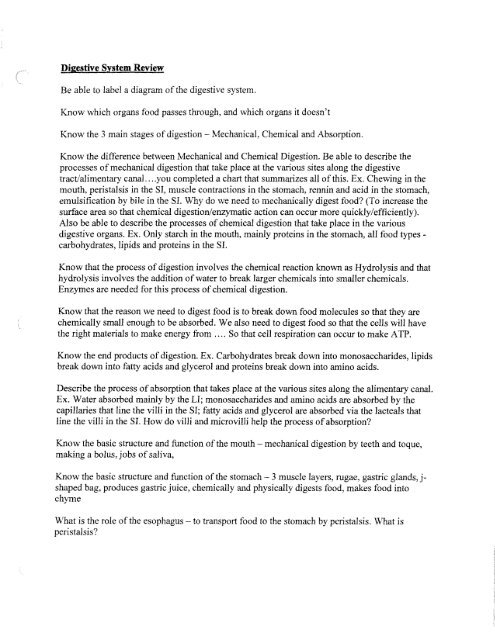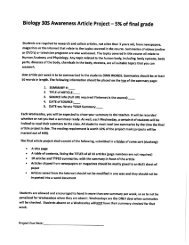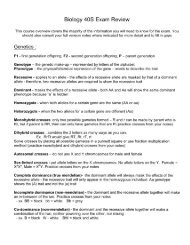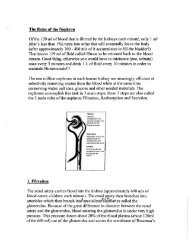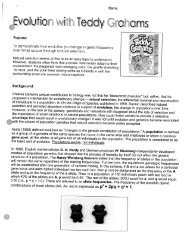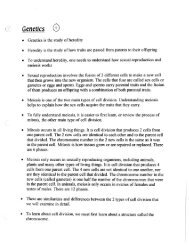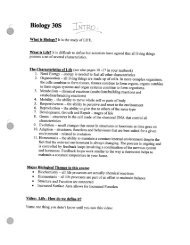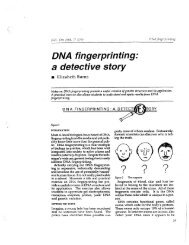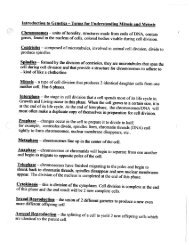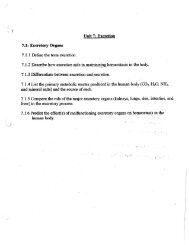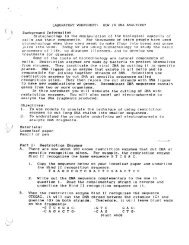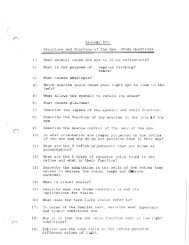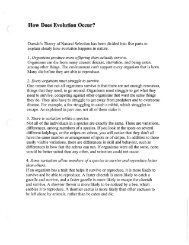Digestive Sys. Review.pdf - Mrs Stovel
Digestive Sys. Review.pdf - Mrs Stovel
Digestive Sys. Review.pdf - Mrs Stovel
You also want an ePaper? Increase the reach of your titles
YUMPU automatically turns print PDFs into web optimized ePapers that Google loves.
<strong>Digestive</strong> <strong>Sys</strong>tem <strong>Review</strong><br />
Be able to label a diagram of the digestive system.<br />
Know which organs food passes through, and which organs it doesn't<br />
Know the 3 main stages of digestion - Mechanical. Chemical and Absorption.<br />
Know the difference between Mechanical and Chemical Digestion. Be able to describe the<br />
processes of mechanical digestion that take place at the various sites along the digestive<br />
tract/alimentary canal. ...you completed a chart that summarizes all of this. Ex. Chewing in the<br />
mouth, peristalsis in the SI, muscle contractions in the stomach, rennin and acid in the stomach,<br />
emulsification by bile in the SL Why do we need to mechanically digest food? (To increase the<br />
surface area so that chemical digestion/enzymatic action can occur more quickly/efficiently).<br />
Also be able to describe the processes of chemical digestion that take place in the various<br />
digestive organs. Ex. Only starch in the mouth, mainly proteins in the stomach, all food types -<br />
carbohydrates, lipids and proteins in the SI.<br />
Know that the process of digestion involves the chemical reaction known as Hydrolysis and that<br />
hydrolysis involves the addition of water to break larger chemicals into smaller chemicals.<br />
Enzymes are needed for this process of chemical digestion.<br />
Know that the reason we need to digest food is to break down food molecules so that they are<br />
chemically small enough to be absorbed. We also need to digest food so that the cells will have<br />
the right materials to make energy from .... So that cell respiration can occur to make ATP.<br />
Know the end products of digestion. Ex. Carbohydrates break down into monosaccharides, lipids<br />
break down into fatty acids and glycerol and proteins break down into amino acids.<br />
Describe the process of absorption that takes place at the various sites along the alimentary canal.<br />
Ex. Water absorbed mainly by the LI; monosaccharides and amino acids are absorbed by the<br />
capillaries that line the villi in the SI; fatty acids and glycerol are absorbed via the lacteals that<br />
line the villi in the SI. How do villi and microvilli help the process of absorption?<br />
Know the basic structure and function of the mouth - mechanical digestion by teeth and toque,<br />
making a bolus, jobs of saliva,<br />
Know the basic structure and function of the stomach - 3 muscle layers, rugae, gastric glands, j-<br />
shaped bag, produces gastric juice, chemically and physically digests food, makes food into<br />
chyme<br />
What is the role of the esophagus -- to transport food to the stomach by peristalsis. What is<br />
peristalsis?
Chapter Four - <strong>Digestive</strong> <strong>Sys</strong>tem PAGE 122<br />
Across<br />
4:<br />
7.<br />
8.<br />
9.<br />
12.<br />
16.<br />
18.<br />
19..<br />
24.<br />
26.<br />
30.<br />
31.<br />
32.<br />
35.<br />
36.<br />
37.<br />
40.<br />
42.<br />
43.<br />
44.<br />
Down<br />
1.<br />
2.<br />
3.<br />
4.<br />
5.<br />
6.<br />
10.<br />
11.<br />
13.<br />
14.<br />
15.<br />
17.<br />
20.<br />
21.<br />
22.<br />
23.<br />
25.<br />
27.<br />
28.<br />
29.<br />
33.<br />
34.<br />
38.<br />
39.<br />
41.<br />
A material released from the pancreas to protect the duodenum<br />
nodes are found abundantly near the intestines<br />
An enzyme that breaks peptide bonds released from the intestinal epithelium<br />
An enzyme that breaks down lactose and released from the intestinal epithelium<br />
Liquid types of lipid<br />
Digested in the . stornach<br />
Produced by the bacteria in the large intestine<br />
A lesion of the digestive lining<br />
A hormone that is released in response to the presence of protein in the stomach<br />
An auxiliary digestive organ,that produces bile<br />
The opposite of even<br />
Muscular wave of constriction<br />
A disaccharide that is digested with the help of lactase<br />
Part of the small intestine that receives chyme from the stomach<br />
An organ that) as both exocrine and endocrine functions<br />
A hormone to at stimulates the pancreas<br />
A portion of the small intestine that releases material into the large intestine<br />
A vessel located in the microvilli responsible for the absorption of lipids<br />
The break-down of fat globs into smaller globules<br />
Inactive form of pepsin<br />
The outer stomach wall is smooth<br />
The epitome of Canadian animalhood<br />
Another term for large intestine<br />
Strong circular muscle that forms a valve<br />
An organism that is normally found in the large intestine but not the stomach<br />
A vestigial organ in the digestive system that is prone to infection<br />
A long muscular tube behind the trachea that passes through the diaphragm<br />
A sac that stores bile .<br />
An enzyme that digests triglycerol molecules and is released from the pancreas<br />
A food type that is better digested if it is emulsified<br />
A structure in the epithelial lining of the digestive tract that increases surface area<br />
The portion of the large intestine that is found near the stomach<br />
An enzyme released by the pancreas and the salivary glands to digest starch<br />
An enzyme released by the pancreas that breaks specific peptide bonds<br />
A monosaccharide that is similar to glucose<br />
The name of the intestine where most water re-absorption occurs<br />
A carbohydrase that breaks down table sugar<br />
Part of the large intestine that stores feces before they are released<br />
An emulsifying agent that is produced from broken-down hemoglobin<br />
Contains gastric glands<br />
A mucus membrane<br />
A portion of the small intestine that is between the duodenum and the ileum<br />
of Langerhans produce hormones<br />
A special mucus that is released by the mucus membrane of the stomach<br />
Required to denature proteins in the stomach
AGE 22 oY<br />
I B t(E<br />
PAGE 1 23<br />
ml<br />
E I M' I I I<br />
T<br />
k<br />
0<br />
9 10<br />
P<br />
12 13 151 1 14 15<br />
0 1 1<br />
ea<br />
1 `"1 1 1I I I I 1 .51 1-1 Gl L<br />
FIt I I I i la V I I I<br />
1441 rrTrnHf j<br />
i}estion Crossword
What are the roles of the LI? (bacterial decomposition of undigested food<br />
absorption of water, solidification of material that will become feces, transfer of waste material<br />
to the rectum)<br />
What is a sphincter? What is its job? What are the names of all 5 sphincters?<br />
What is the pH of the stomach? What is the pH of the SI. Why are they different? Why is it<br />
important that they are different? What is Hl and what is Sodium Bicarbonate?<br />
How do the bacteria that live in our large intestine help us?<br />
What is bile and what does it do? Where is it made and where is it produced? Where is bile used<br />
and how does it get there? What is emulsification?<br />
What 3 secretions are present in the SI?<br />
Know the digestive disorders from your disorders assignment.. .gingivitis, hepatitis, etc... Also<br />
add to the list irritable bowel syndrome (the bowel - LI/rectum is over-reactive to certain<br />
chemicals in food and certain stressors and causes cramping pain and diarrhea) and lactose<br />
intolerance (milk and milk products cause irritable bowel syndrome due to the fact that the body<br />
does not produce enough of the enzyme lactase).<br />
We need fibre as a part of a healthy diet yet we can't digest it. Why can't we digest it? Why do<br />
we need fibre?<br />
What is the role of mucus in the mouth? In the stomach? In the SI?<br />
Be able to list the components of saliva, gastric juice, pancreatic juice, intestinal juice (you<br />
completed a chart on this). Know what each component is responsible for.<br />
Control of Digestion is by a combination of nerves and hormones.... know your charts.<br />
Blood sugar levels are maintained by the opposing affects of insulin and glucagon. Be able to<br />
explain exactly how they control the BSL.<br />
Know the names of enzymes which digest each type of food - amylase for starch, lipase for<br />
lipids, nucleases for nucleic acids, peptidases (any name with "pep" or "pro" in it) for proteins.<br />
Also know that sugar enzyme names match the names of sugars (maltase for maltose)<br />
What are peptones and proteoses?<br />
Why are pepsinogen and chymotrypsinogen secreted as inactive enzymes? What activates them?<br />
What are the functions of the liver?(storage of glycogen, detoxification of harmful chemicals like<br />
alcohol, formation of bile salts, secretion of bile)
LHIL
Fill in the blank spaces in the table.<br />
In the Released From column, place one or more numbers from list 1.<br />
In the Acts On column, place one or more letters from list 11.<br />
In some cases, more than one answer is possible; include all that apply<br />
The first one has been done for you<br />
tI<br />
1. stomach<br />
2. pancreas<br />
3. liver<br />
4. small intestine<br />
5. large intestine<br />
6. salivary glands<br />
7. gall bladder<br />
List II<br />
a. lipids<br />
b. maltose<br />
c. starch<br />
d. sucrose<br />
e. milk<br />
f protein<br />
g. one specific type of protein<br />
h. acids<br />
i. lactose<br />
j. nothing<br />
k. nucleic acids<br />
Name of Secretion Released From Acts on<br />
Saliv Amylase 6 c<br />
Ere sin<br />
Pancreatic Am lase<br />
Maltase<br />
Lactase<br />
Sucrase<br />
T sin<br />
Pepsin<br />
Pe lino en<br />
Peptidase<br />
Sodium bicarbonate<br />
Li ase<br />
Bile<br />
Hydrochloric Acid<br />
Ch mo sino en<br />
Nuclease<br />
Rennin


